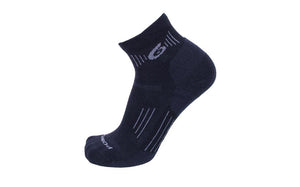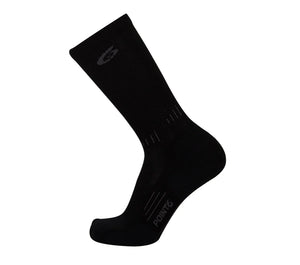
While not all furry friends are born to chase your wheel (like Pugs), there are some dogs who are meant to shred. We have a few of those pups on the Point6 team, like my dog Odee. However, riding with him while on my bike was not always easy. Odee is a mixed border collie rescue pup who definitely has some tendencies to be spooked by sporadic movements, large boxes, and rolling wheels. As a passionate mountain biker, I’m totally OK that whenever I pick up trash, or receive a package, he runs away- but I could not have him running away every time we decided to take him with us on a mountain bike ride.
If you have a dog that you’ve always wanted to take with you mountain biking, but you’re not sure how to begin, I’ve compiled some tips, tricks, and advice to help get you started so that you too can have a happy and exhausted dog at the end of the day :)
- Wait til they’re old enough- Dogs' growth plates don’t fully develop until 12-18 months depending on the breed. That said, you can still start training them for biking earlier than that. Just don’t get them up to full speed.
- Learn where you can (or can’t) ride with your dog -A lot of trails have leash requirements especially if you are in an urban area. Make sure it is OK to have Fido off leash both during training and then later when you select the places to ride him.
- Get a “Runner’s Leash” -Most stores have them and the leash attaches around your waist and has “bungee” for give. This leaves your hands free for staying on your bike so you can brake in an instant when needed.
- Use the “Runner’s Leash” at first- It will get them used to being next to you and the bike. With the “pull” coming from your waist instead of your hand, it’s much safer to endure a slight pull from the dog this way.
- Put the dog on the right side- As in right, not left. That way if you ever have to leash him up on a road and ride back to the parking lot, he is safe on the inside.
- Teach the command “Wait” - This helps them slow down and not pull you too much. (Though I’ll admit, a slight pull up a hill feels really nice!).
- Teach them "out" or "move"- This is important for when you do catch up to them that they know to move fully off the trail. You can train this on leash while walking or biking and then after some practice they'll understand and eventually connect the sound of the tire behind them and your command to get out of the way so they don't get run over.
- Use treats for positive reinforcement whenever possible - Keep them in your fanny pack or a shorts pocket for easy access. Your dog will be much more responsive to commands or recall if a sweet treat is waiting for them.
- Have a good recall program - Whether that’s really good recall, or an e-collar. It’s SUPER important to be able to get your dog back when you need them to come back. It’s a wild world out there and I can guarantee you that a deer is waaaaay more exciting than any singletrack is to a dog. We used Sit Means Sit in Denver for e-collar training and it was worth EVERY PENNY. Think of it as a tap to get their attention.
- Start slow & build their endurance- Just like teaching your dog to walk on a leash, teaching them to ride with a bike is no different. Choose a wider trail at first or even better, an off leash area with lots of room to stop and go and turn around. For your first ride, don’t go too far. Mountain biking is a lot faster pace (especially going down) than running would be so you need to be cognizant of length, weather, and pace of the ride.
- Ride behind them - This could be debatable but it is what we prefer to do with Odee. Mostly because he’s the fastest dog we ever met and it’s nice to have him set the pace. If you always ride in front, your pace could be too fast, but they don’t realize it and they push it too hard trying to keep up. It’s also really adorable when I’m riding in the back and Odee waits for me with a big smile on his face to make sure I’m still there.
- Rest, Water, Water, Repeat- Take frequent breaks especially at the beginning. Pay attention to your dog’s energy levels and make sure they have plenty of water. This REQUIRES carrying water for them (and training them to drink out from the stream of water coming from a bottle). I would not recommend putting on a pack for them to carry their own water as the pace is too fast. Would you wanna run with backpack full of water?
- Snacks! -If going for longer than an hour, remember that your dog needs nutrition too. A little ziplock of kibble or a meat stick will work great. If you’re super fancy and creative, you could always make doggie bars to bring with you.
- Enjoy a happy and sleepy dog! - What once was an anxious and excited dog in the car ride to the trailhead is now a tired, mellow angel. Enjoy this time and I guarantee you’ll get extra cuddles for days to come.
Additionally, the AKC has some advice regarding running with your dog, and all of their advice applies to mountain biking as well. Be prepared, be aware, and HAVE FUN!
- Warm up your dog before you run and cool them down when you’re finished by walking for several minutes.
- Be aware of weather conditions. Dogs can’t handle heat and humidity as well as humans can.
- Carry water on your walks and offer it to your dog regularly.
- Give your dog frequent breaks, so they can recharge, go to the bathroom, and enjoy their surroundings.
- Only allow your dog to run off-leash where it’s safe and legal, and only if they have a reliablerecall amid distractions.
- Watch your dog for signs that they’ve had enough, such as excessive panting or lagging behind you. Dogs may run to please their owner, even when they want to stop.
Words & Photos by Odee's parents Liz Cunningham & Ben Duke






